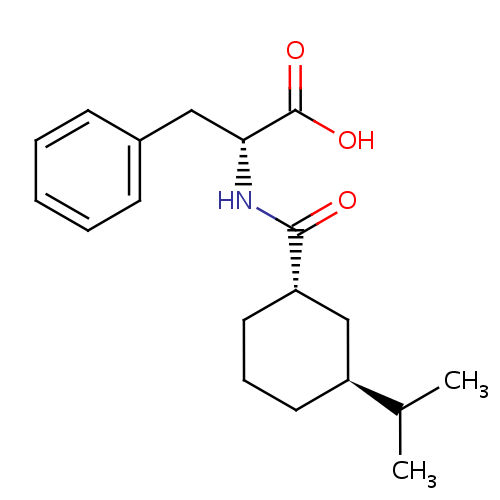Nateglinide(那格列奈)

Monoisotopic: 317.199093735
Nateglinide is an oral antihyperglycemic agent used for the treatment of non-insulin-dependent diabetes mellitus (NIDDM). It belongs to the meglitinide class of short-acting insulin secretagogues, which act by binding to β cells of the pancreas to stimulate insulin release. Nateglinide is an amino acid derivative that induces an early insulin response to meals decreasing postprandial blood glucose levels. It should only be taken with meals and meal-time doses should be skipped with any skipped meal. Approximately one month of therapy is required before a decrease in fasting blood glucose is seen. Meglitnides may have a neutral effect on weight or cause a slight increase in weight. The average weight gain caused by meglitinides appears to be lower than that caused by sulfonylureas and insulin and appears to occur only in those naïve to oral antidiabetic agents. Due to their mechanism of action, meglitinides may cause hypoglycemia although the risk is thought to be lower than that of sulfonylureas since their action is dependent on the presence of glucose. In addition to reducing postprandial and fasting blood glucose, meglitnides have been shown to decrease glycosylated hemoglobin (HbA1c) levels, which are reflective of the last 8-10 weeks of glucose control. Meglitinides appear to be more effective at lowering postprandial blood glucose than metformin, sulfonylureas and thiazolidinediones. Nateglinide is extensively metabolized in the liver and excreted in urine (83%) and feces (10%). The major metabolites possess less activity than the parent compound. One minor metabolite, the isoprene, has the same potency as its parent compound.
- Dr reddys laboratories ltd
- Novartis pharmaceuticals corp
- Par pharmaceutical inc
- Teva pharmaceuticals usa
- Caremark LLC
- Doctor Reddys Laboratories Ltd.
- Heartland Repack Services LLC
- Mckesson Corp.
- Novartis AG
- Par Pharmaceuticals
- Physicians Total Care Inc.
- Resource Optimization and Innovation LLC
- Vangard Labs Inc.
| Synthesis Reference | Not Available |
| General Reference | Not Available |
| Type | small molecule |
| Classes | Not Available |
| Substructures | Not Available |
| Indication | For the treatment of non-insulin dependent-diabetes mellitus in conjunction with diet and exercise. | ||||||
| Pharmacodynamics | Insulin secretion by pancreatic β cells is partly controlled by cellular membrane potential. Membrane potential is regulated through an inverse relationship between the activity of cell membrane ATP-sensitive potassium channels (ABCC8) and extracellular glucose concentrations. Extracellular glucose enters the cell via GLUT2 (SLC2A2) transporters. Once inside the cell, glucose is metabolized to produce ATP. High concentrations of ATP inhibit ATP-sensitive potassium channels causing membrane depolarization. When extracellular glucose concentrations are low, ATP-sensitive potassium channels open causing membrane repolarization. High glucose concentrations cause ATP-sensitive potassium channels to close resulting in membrane depolarization and opening of L-type calcium channels. The influx of calcium ions stimulates calcium-dependent exocytosis of insulin granules. Nateglinide increases insulin release by inhibiting ATP-sensitive potassium channels in a glucose-dependent manner. | ||||||
| Mechanism of action | Nateglinide activity is dependent on the presence functioning β cells and glucose. In contrast to sulfonylurea insulin secretatogogues, nateglinide has no effect on insulin release in the absence of glucose. Rather, it potentiates the effect of extracellular glucose on ATP-sensitive potassium channel and has little effect on insulin levels between meals and overnight. As such, nateglinide is more effective at reducing postprandial blood glucose levels than fasting blood glucose levels and requires a longer duration of therapy (approximately one month) before decreases in fasting blood glucose are observed. The insulinotropic effects of nateglinide are highest at intermediate glucose levels (3 to 10 mmol/L) and it does not increase insulin release already stimulated by high glucose concentrations (greater than 15 mmol/L). Nateglinide appears to be selective for pancreatic β cells and does not appear to affect skeletal or cardiac muscle or thyroid tissue. | ||||||
| Absorption | Rapidly absorbed following oral administration prior to a meal, absolute bioavailability is estimated to be approximately 73%. Peak plasma concentrations generally occur within 1 hour of oral administration. Onset of action is <20 minutes and the duration of action is approximately 4 hours. | ||||||
| Volume of distribution | 10 liters in healthy subjects |
||||||
| Protein binding | 98% bound to serum proteins, primarily serum albumin and to a lesser extent α1 acid glycoprotein | ||||||
| Metabolism |
Hepatic, via cytochrome P450 isoenzymes CYP2C9 (70%) and CYP3A4 (30%). Metabolism is via hydroxylation followed by glucuronidation. The major metabolites have less antidiabetic activity than nateglinide, but the isoprene minor metabolite has antidiabetic activity comparable to that of nateglinide.
|
||||||
| Route of elimination | Urine (83%) and feces (10%) | ||||||
| Half life | 1.5 hours | ||||||
| Clearance | Not Available | ||||||
| Toxicity | An overdose may result in an exaggerated glucose-lowering effect with the development of hypoglycemic symptoms. | ||||||
| Affected organisms |
|
||||||
| Pathways |
|
| Properties | |||||||||||||||||||||||||||||||||||||||||||
|---|---|---|---|---|---|---|---|---|---|---|---|---|---|---|---|---|---|---|---|---|---|---|---|---|---|---|---|---|---|---|---|---|---|---|---|---|---|---|---|---|---|---|---|
| State | solid | ||||||||||||||||||||||||||||||||||||||||||
| Experimental Properties |
|
||||||||||||||||||||||||||||||||||||||||||
| Predicted Properties |
|
||||||||||||||||||||||||||||||||||||||||||
| Drug | Interaction |
|---|---|
| Glucosamine | Possible hyperglycemia |
| Somatropin recombinant | Somatropin may antagonize the hypoglycemic effect of nateglinide. Monitor for changes in fasting and postprandial blood sugars. |
| Telithromycin | Telithromycin may reduce clearance of Nateglenide. Consider alternate therapy or monitor for changes in the therapeutic/adverse effects of Nateglenide if Telithromycin is initiated, discontinued or dose changed. |
| Tolbutamide | Tolbutamide, a strong CYP2C9 inhibitor, may decrease the metabolism and clearance of Nateglinide. Consider alternate therapy or monitor for changes in Nateglinide therapeutic and adverse effects if Tolbutamide is initiated, discontinued or dose changed. |
| Voriconazole | Voriconazole, a strong CYP3A4 inhibitor, may increase the serum concentration of nateglinide by decreasing its metabolism. Monitor for changes in the therapeutic and adverse effects of nateglinide if voriconazole is initiated, discontinued or dose changed. |
- Take upto 30 minutes before meals.
